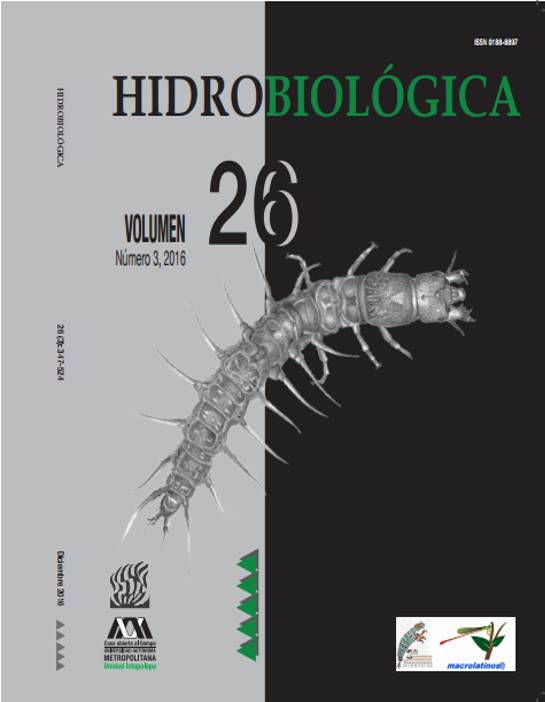Water quality characterization of benthonic macroinvertebrates of Puyo river, Ecuadorian Amazonia
DOI:
https://doi.org/10.24275/uam/izt/dcbs/hidro/2016v26n3/RodriguezKeywords:
Arthropods, biological index, BMWP-CR, IBF-SV, PastazaAbstract
Background. In 2012, a biologic water quality study was conducted in the central part of Río Puyo, in Pastaza Province. The river is characterized for an increasing environmental degradation due to a rise in population with a simultaneous housing development increase. Goals. To assess Rio Puyo water quality with macroinvertebrate monitoring and chemical parameters. Methods. The macroinvertebrates were collected at four different dates, and two biotic indexes, Biological Monitoring Working Party for Costa Rica (BMWP-CR) and Biological Family Index for El Salvador (IBF-SV), were determined
for each site. The study was complemented with pH and dissolved oxygen sampling to determine their correlation with the biotic indices. Results. There were 14 orders, 40 families and 2 808 individuals identified, most of the especimens belong to Leptohyphidae (23.3%) and Hydropsychidae (18.7%) families. The indexes showed that the water quality in the river drops significantly between points 1 (Fátima) and 3 (La Isla), showing some increase at point 4 (Unión Base). A 5%
significance correlation were established between dissolved oxygen and BMWP-CR index (r=0.915), and 1% significance correlation between BMWP-CR an IBF-SV index (-0.947). Conclusions. all indexes show a significant drop of quality at the urban areas, one of them (IBF-SV) shows some recovery when the river leaves the city.
Downloads
Downloads
How to Cite
Issue
Section
License
Los autores/as que publiquen en esta revista aceptan las siguientes condiciones:
De acuerdo con la legislación de derechos de autor, HIDROBIOLÓGICA reconoce y respeta el derecho moral de los autores, así como la titularidad del derecho patrimonial, el cual será cedido a la revista para su difusión en acceso abierto.
Publicar en la revista HIDROBIOLÓGICA tiene un costo de recuperación de $500 pesos mexicanos por página en blanco y negro (aproximadamente 29 dólares americanos) y $1000 pesos por página a color (aproximadamente 58 dólares americanos).
Todos los textos publicados por HIDROBIOLÓGICA sin excepción se distribuyen amparados bajo la licencia Creative Commons 4.0Atribución-No Comercial (CC BY-NC 4.0 Internacional), que permite a terceros utilizar lo publicado siempre que mencionen la autoría del trabajo y a la primera publicación en esta revista.
Los autores/as pueden realizar otros acuerdos contractuales independientes y adicionales para la distribución no exclusiva de la versión del artículo publicado en HIDROBIOLÓGICA (por ejemplo incluirlo en un repositorio institucional o publicarlo en un libro) siempre que indiquen claramente que el trabajo se publicó por primera vez en HIDROBIOLÓGICA.
Para todo lo anterior, el o los autor(es) deben remitir el formato de Carta-Cesión de la Propiedad de los Derechos de la primera publicación debidamente requisitado y firmado por el autor(es). Este formato se puede enviar por correo electrónico en archivo pdf al correo: enlacerebvistahidrobiológica@gmail.com; rehb@xanum.uam.mx (Carta-Cesión de Propiedad de Derechos de Autor).
Esta obra está bajo una licencia de Creative Commons Reconocimiento-No Comercial 4.0 Internacional.


